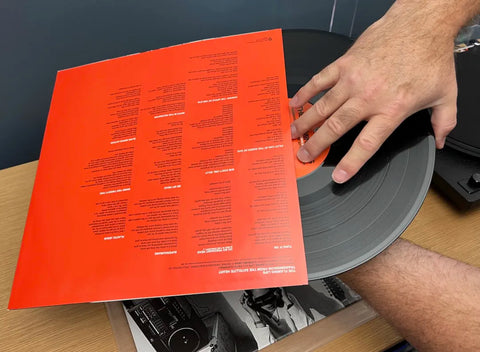You've just got your first record player, and you're all set to dive into the world of vinyl. Congratulations! You're about to enjoy music in one of the most immersive ways possible.
How exactly do you operate a record player (or turntable, to be precise)?
Vinyl lovers often assume everyone knows how to use a turntable, but is that the case? While vinyl is making a comeback in our digital age, it can feel daunting if you've never used one before.
The good news is that playing a record is simpler than you might think!
What Type of Record Player or Turntable Do You Own?
There are four main types of record player:
- All-in-One Record Player with Built-in Speakers
- Automatic Turntables
- Manual Turntables
- Semi-Automatic Turntables

How to Use a Record Player with Built-in Speakers?
You can start playing records immediately if you own an all-in-one record player with built-in speakers, like the portable models from manufacturers such as Crosley, seasonlife, and Victrola.
These turntables are designed as portable all-in-one devices, making them ideal for beginners. However, the vinyl community often scoffs at these brands because they can't deliver the same high-fidelity experience as more expensive turntable models.
That being said, if this type of player helps you embark on your vinyl adventure, it's definitely worth it!
Your all-in-one record player likely comes with a set of built-in speakers, so there's no need to connect it to a separate receiver, amplifier, or external speakers.
The built-in speakers are sufficient to get you started, but if you find the sound a bit lacking, you can connect the turntable to external speakers for a noticeable quality improvement.
Many of these devices feature RCA output connectors on the back, allowing you to plug into the “AUX” input of a receiver or speaker for better sound.
Additionally, more and more models are equipped with Bluetooth connectivity, providing a convenient way to connect to your existing home entertainment system or even smart speakers.
1. Familiarize yourself with the parts of your record player:
You should find a diagram of your record player in the owner’s manual.
- Start/Stop button or knob, which you need to press to get your record playing or stopping.
- Cueing lever, which allows you to raise or lower the tone arm.
- Speed selector, which allows you to select either 33 or 45 revolutions per minute, depending on the speed indicated on your vinyl record.
- Record size selector on automatic record players. This selector allows you to choose whether you want to play a 12 or a 7-inch vinyl record.
- Tone arm and cartridge,your tonearm pivots from the outside edge of the record toward the center. At the end of a tonearm is your cartridge, which has a needle (better known as the stylus) responsible for tracking your record’s groove.

2. Setting Up the Record Player
To ensure your record player functions correctly, place it on a flat, level surface. Use a level with a bubble vial to check the surface where you plan to set up your record player. Position the level on the table or shelf, and make adjustments to the furniture until the bubble is centered in the vial. When the bubble stays in the center, the surface is properly leveled.
If the table, shelf, or any other surface isn’t completely level, the record player won’t operate correctly. You might need to insert some wooden shims under the furniture to achieve the right level.
3. Plug in your record player
The record player requires electricity, so you will need to plug it into a secure outlet.

4. Playing a Record
1) Take the record out of the sleeve
Be careful not to touch the record grooves. Always hold your records by the edges and label so as not to dirty up the record with oils from your fingertips.
2) Place the record
Place the record on the plater so the spindle goes through the center hole of the record. Each side is labeled A & B (possibly C & D also if it’s a double LP).
3) Make sure the speed is correct
In the middle of your record, you should see the speed indicated.
Most 12-inch LPs are 33 1/3 RPM and 7-inch singles are 45 RPM.Some 12-inch vinyl records play at 45 revolutions per minute.
After determining the correct speed for the record, make sure your record player is adjusted for this speed by clicking the speed selector button.
Most record players and turntables have a simple switch somewhere on the plinth to adjust speed.
To adjust the speed on some manual players, you may have to take off the platter. Then, move the belt to the appropriate groove for either 33 1/3rd or 45 revolutions per minute. The appropriate groove should be indicated in your owner’s manual.
5. Check the cue lever
If your record player has a cue lever for raising and lowering the tonearm, use it!
Don’t attempt to raise and lower the tonearm on your records by hand if you don’t have to – you’ll undoubtedly risk scratching a record eventually
6. Align the tone arm with the record
With the cue lever set to the up position, slowly pivot the tonearm over to the edge of your record.
Using your eye, look down to ensure the stylus (or needle if you prefer) is hovering just inside the disc.
7. Lower the tonearm
Once the tone arm is aligned with the record, press the cueing lever down to let the tone arm fall down to the record.
If you drop the tone arm down and it misses the side of the record or starts playing the wrong song, press the cueing lever to raise the tonearm back up. Then, try to align the tonearm with the side of the record and drop it down again.
8. Stop the music
Unlike using an MP3 player or a CD player, stopping a record player requires manual action. To do this, lift the tonearm by using the cueing lever. Next, position the tonearm back to its resting place and press the stop button or switch.
9. Play the music on an automatic turntable
If you are using an automatic turntable, you just need to press the play/stop button. The record will automatically play. When the side of the record is finished, press stop.
Summary
The content above primarily discusses the usage of all-in-one record players with built-in speakers. Some of these methods are also applicable to other types of turntables. In the future, additional guides for using different types of turntables will be provided.
Tips:After you start using your turntable, don't forget to learn how to maintain and clean a record player.
.










Leave a comment
All comments are moderated before being published.
This site is protected by hCaptcha and the hCaptcha Privacy Policy and Terms of Service apply.